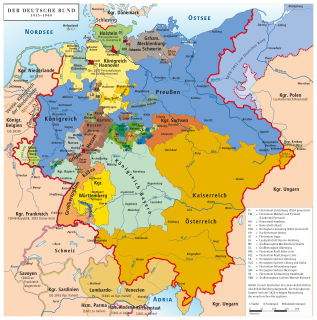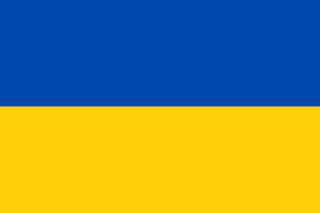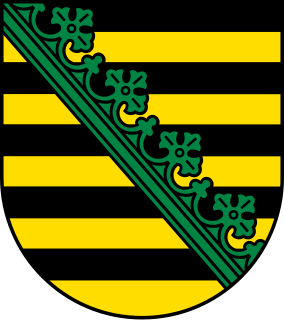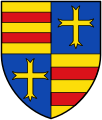
Lower Saxony is a German state (Land) situated in northwestern Germany. It is the second-largest state by land area, with 47,624 km2 (18,388 sq mi), and fourth-largest in population among the 16 Länder federated as the Federal Republic of Germany. In rural areas, Northern Low Saxon and Saterland Frisian are still spoken, albeit in declining numbers.

Westphalia is a region of northwestern Germany and one of the three historic parts of the state of North Rhine-Westphalia. It has an area of 20,210 square kilometres (7,800 sq mi) and 7.9 million inhabitants.
Schaumburg is a district (Landkreis) of Lower Saxony, Germany. It is bounded by the districts of Nienburg, Hanover and Hamelin-Pyrmont, and the state of North Rhine-Westphalia.

The states of the German Confederation were member states of the German Confederation, from 20 June 1815 until 24 August 1866.

The Duchy of Brunswick was a historical German state. Its capital was the city of Brunswick . It was established as the successor state of the Principality of Brunswick-Wolfenbüttel by the Congress of Vienna in 1815. In the course of the 19th-century history of Germany, the duchy was part of the German Confederation, the North German Confederation and from 1871 the German Empire. It was disestablished after the end of World War I, its territory incorporated into the Weimar Republic as the Free State of Brunswick.

The Province of Hanover was a province of the Kingdom of Prussia and the Free State of Prussia from 1868 to 1946.

The Free State of Brunswick was a state of the German Reich in the time of the Weimar Republic. It was formed after the abolition of the Duchy of Brunswick in the course of the German Revolution of 1918–19. Its capital was Braunschweig (Brunswick).
This is a list of coats of arms of Germany.

The coat of arms of North Rhine-Westphalia is the official coat of arms of the German state of North Rhine-Westphalia.

The coat of arms of the present-day German free state of Saxony shows a tenfold horizontally-partitioned field of black (sable) and gold/yellow (or) stripes, charged with a green (vert) crancelin running from the viewer's top-left to bottom-right. Although the crancelin is sometimes shown bent (embowed) like a crown, this is due to artistic license. The coat of arms is also displayed on the state flag of Saxony.

Both the civil and state flag of the German state of Thuringia feature a bicolour of white over red. Introduced with the formation of the state of Thuringia within the Weimar Republic in 1920, it is the reverse of the flag of Hesse, both flags ultimately reflecting the heraldic colours of the Ludovingian rulers of the medieval Duchy of Thuringia. The flag's similarity to that of Poland is coincidental.

Both the civil and state flag of the German state of Saxony feature a bicolour of white over green, similar to the Austrian province of Styria although they are historically not related to each other. The state flag is similar to the civil flag, except it is defaced in the centre with the coat of arms of Saxony. The colours of both flags were officially decided as state colours in 1815. The aristocracy used mostly and in first time the quadrangular version and later the rectangular.

The Saxon Steed is a heraldic motif associated with the German provinces of Lower Saxony and Westphalia, and the Dutch region of Twente.

The coat of arms of Oldenburg is the coat of arms associated with the state of Oldenburg, a county, duchy and then grand duchy that existed between 1101 and 1918. The arms are also associated with the parts of the House of Oldenburg that ruled the state.

The State of Hanover was a short-lived state within the British Zone of Allied-occupied Germany. It existed for 92 days in the course of the dissolution of the Free State of Prussia after World War II until the foundation of Lower Saxony in 1946. The state saw itself in the tradition of the former Kingdom of Hanover, annexed by Prussia in 1866, reflected in the Saxon Steed state emblem. After Lower Saxony was founded by merging Hanover with several smaller states, it continued to use the Hanover emblems.

The Minister-President of Lower Saxony, also referred to as Premier or Prime Minister, is the head of government of the German state of Lower Saxony. The position was created in 1946, when the states of Brunswick, Oldenburg, Schaumburg-Lippe and the State of Hanover were merged to form the state of Lower Saxony. The current Minister President is Stephan Weil, heading a coalition government between the Social Democrats and the CDU. Weil succeeded David McAllister following the 2013 state election.

The flag of Lower Saxony consists of the flag of the Federal Republic of Germany in Schwarz-Rot-Gold, with the coat of arms of Lower Saxony, shifted slightly toward the hoist. This flag is the civil and state flag. A double tailed version in 3:5 ratio is used as the state ensign.
The North German Confederation Treaty was the treaty between the Kingdom of Prussia and other northern and central German states that initially created the North German Confederation, which was the forerunner to the German Empire. This treaty, and others that followed in September and October, are often described as the August treaties, although not all of them were concluded in August 1866.

The House Order of Henry the Lion In German: Hausorden Heinrichs des Löwen, was the House Order of the Duchy of Brunswick. It was instituted by William VIII, Duke of Brunswick on 25 April 1834. The ribbon of the Order was red with yellow edges. It had five grades: Grand Cross, Grand Commander with Sash, Commander, Knight 1st Class, Knight 2nd Class, plus Medal of Merit for Science and Arts, the Cross of Merit and the Medal of Honour. The Order was named in honour of Henry the Lion, who remains a popular figure to this day.





























